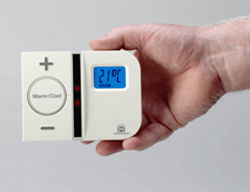For many years – at least the past 20 – the Horstmann Controls 425 Series electro-mechanical central heating programmer has been one of the most popular, cost effective and simplest methods of controlling hot water and central heating in the home.

The combination of dials and on/off levers with the choice of single circuit (The Coronet) or twin circuit versions (The Tiara) make them popular not only in domestic environments but also in areas such as sheltered accommodation and housing associations. And the 425’s days are far from numbered. In this age of advanced electronics and the growing trend towards RF technology, Horstmann still sells them in thousands and remains confident they have a place – albeit possible a niche – alongside their electronic cousins.
On Horstmann’s admission, the 425 is very much a case of ‘what you see is what you get!”
However, advances in electronics and the need for greater sophistication in controlling multi-heating periods during a typical 24 hours brought forward the era of the electronic programmer. And with it, as Paul Lovegrove, sales manager of Bristol based Horstmann Controls explains, they brought a new problem – ‘complication’.
“I liken electronic programming in many ways to the problems people find with programming their DVD recorder,” claims Paul. “If it’s too complicated leave it as it is; and in many cases this leads to wildly inaccurate programming with consequent heavy energy bills – the last thing we need at present.”
Three years ago, Horstmann design engineers set out to develop an innovative electronic alternative version of the 425 – combining functionality with ease of use while incorporating a number of necessary sophistications.
“We called it the ThermoPlus programmable room thermostat and it represents probably the biggest advance in the design of central heating controls since the first electronic programmer,” claims Paul Lovegrove.
Horstmann’s design team developed the thermostat using their unique ‘AS’ technology process, a technique that has the threefold objective of combining high performance with advanced technology and ease of use.
Being aware – through market feedback - that ever sophisticated central heating controls were also becoming more and more complex for the householder to operate, the Horstmann design team adopted a ‘clean sheet of paper’ approach when developing the concept designs for ThermoPlus.
“They were looking to develop a product that would revolutionise the way central heating controls look and operate, a process that involved a complete re-evaluation of the traditional approach and concentrating purely on the user viewpoint,” adds Paul Lovegrove.
At the time, ThermoPlus - or a derivative of it – was competing to be specified as the preferred choice for the Defra funded Warm Front scheme with the design team very focused on ease of use for the elderly or less able user. It had to be recognised that in some cases, users of Warm Front installations are not used to having central heating, let alone using the controls properly.
Horstmann were able to draw upon research carried out by the National Energy Action charity (NEA) which identified problems with time and temperature controls fitted to earlier Warm Front heating systems. ‘Difficult or complicated to use’ was typical feedback, and Horstmann also took into account industry views, those of installers and such respected bodies as ‘Ricability’.
“We felt that if we met the ease of use criteria while maintaining the operational parameters, the programmable ‘stat would not only be suited to Warm Front use but also would find very high acceptability in the broader market,” adds Paul Lovegrove.
Horstmann were subsequently awarded the contract to supply Warm Front with ThermoPlus programmable controls and their installation is becoming increasingly wide spread throughout this on-going and recently upgraded project.
However, that contract aside, in ThermoPlus they have developed a visually different time and temperature controller that also operates in a quite revolutionary way.
Eliminated is a complex appearance and layout, programming complexity, unnecessary user options, multi-purpose buttons, poor display visibility and over-complicated instructions. The programmer also features chrono-proportional thermostat control software to optimize the boiler firing cycle.
ThermoPlus has features such as a colour coded, bright LED warm/cool display, automatic winter and summer time change, frost protection and audible feedback for selecting warm/cool settings. All are designed to enable the user to easily understand and alter the settings.
In effect, there are three buttons for everyday use; A large plus (+) and minus (-) rocker button to increase or decrease temperatures and a central ‘change’ button with Braille markings for warm/cool. As alterations are made, the lit LED display increases the number of red blocks displayed as the temperature is increased while when moving to cool, it changes to blue.
There is also an optional hypothermia protection feature which prevents the room temperature from dropping below 15ºC as well as a button operated stand-by mode to activate frost protection (5º to 10º).
There are now four versions of the ThermoPlus programmer. The AS2 RF is a wireless version and is battery powered, making use of advanced Z-Wave™ mesh wireless control language. This substantially reduces installation times and the disruptions and décor damage associated with hard wiring. The technology is also highly reliable and permits easy network management.
The ThermoPlus AS1 is the mains powered option, ThermoPlus AS2 is the standard battery powered model and ThermoPlus PRT1 has been especially designed for vulnerable/elderly users.
“My enthusiasm for the ThermoPlus is well founded because it is so easy to use and contributes significantly to cost savings and heating efficiency in domestic applications,” concludes Paul Lovegrove. “With the Warm Front installations and a growing number in residences where the users are frail or vulnerable, it also allows the user full and simple control so that heating costs do not run away.
“It’s been a success from day one and shows the benefit of designers being able to stand back from existing approach and apply new thinking in a manner that is both logical and cost effective,” he concludes.
